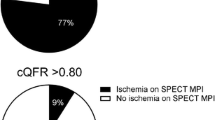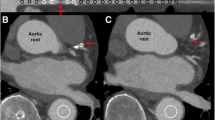Abstract
Background
Functional assessment of myocardial ischemia is critical for patients with intermediate coronary stenosis. As the diagnosis performance of absolute quantification of myocardial blood flow (MBF) and myocardial flow reserve (MFR) by single-photon emission tomography (SPECT) has been proven, its prognostic value in patients with intermediate coronary stenosis remains to be evaluated.
Methods
Patients with one or more target lesions of ≥ 50% to ≤ 80% diameter stenoses on invasive coronary angiography were prospectively included in this study. All patients were scheduled for clinically indicated SPECT myocardial perfusion imaging (MPI) within 3 months and agreed to provide informed consent to participate in quantitative SPECT acquisitions to obtain MBF and MFR values. The primary endpoint was defined as a composite of the major adverse cardiac events (MACE): Cardiac death, myocardial infarction, late revascularization and heart failure or unstable angina-related rehospitalization.
Results
One hundred and nineteen patients (mean age 57 ± 8 years, 62.2% men) were included in the analysis. The average lumen stenosis of patients was 67.0 ± 10.4%. Over a median follow-up duration of 1408 days (interquartile range 1297-1666 days), 18 patients (15.1%) had MACE. Patients with impaired MFR (MFR < 2) had a significantly higher incidence of events than those with preserved MFR (MFR ≥ 2) in Kaplan-Meier survival analysis (Log-rank = 8.105, P = 0.004), while no significant difference was found between patients with normal relative perfusion and those with relative perfusion abnormalities (log-rank = 0.098, P > 0.05). In a multivariate Cox hazards analysis, the SPECT-derived MFR remained an independent predictor of MACE (HR 0.352, 95% CI 0.145-0.854, P = 0.021).
Conclusions
In a cohort of patients with angiographic intermediate coronary lesions, SPECT-derived MFR was an independent predictor of prognosis.




Similar content being viewed by others
Abbreviations
- CAD:
-
Coronary artery disease
- CI:
-
Confidence interval
- FFR:
-
Fractional flow reserve
- HR:
-
Hazard ratio
- MACE:
-
Major adverse cardiac events
- MBF:
-
Myocardial blood flow
- MFR:
-
Myocardial flow reserve
- MI:
-
Myocardial infarction
- MPI:
-
Myocardial perfusion imaging
- PET:
-
Position emission tomography
- SPECT:
-
Single-photon emission computed tomography
- SSS:
-
Summed stress score
References
Knuuti J, Wijns W, Saraste A, et al. 2019 ESC Guidelines for the diagnosis and management of chronic coronary syndromes. Eur Heart J 2020;41:407‐77.
Lawton JS, Tamis-Holland JE, Bangalore S, et al. 2021 ACC/AHA/SCAI Guideline for Coronary Artery Revascularization: Executive Summary: A Report of the American College of Cardiology/American Heart Association Joint Committee on Clinical Practice Guidelines. Circulation. 2022;145(3).
Tebaldi M, Biscaglia S, Fineschi M, et al. Evolving routine standards in invasive hemodynamic assessment of coronary stenosis: The nationwide Italian SICI-GISE cross-sectional ERIS study. JACC Cardiovasc Interv 2018;11:1482‐91.
Hachamovitch R, Berman DS, Shaw LJ, et al. Incremental prognostic value of myocardial perfusion single photon emission computed tomography for the prediction of cardiac death: differential stratification for risk of cardiac death and myocardial infarction. Circulation 1998;97:535‐43.
Iskandrian AS, Chae SC, Heo J, Stanberry CD, Wasserleben V, Cave V. Independent and incremental prognostic value of exercise single-photon emission computed tomographic (SPECT) thallium imaging in coronary artery disease. J Am Coll Cardiol 1993;22:665‐70.
Ben-Haim S, Murthy VL, Breault C, et al. Quantification of myocardial perfusion reserve using dynamic spect imaging in humans: A feasibility study. J Nucl Med 2013;54:873‐9.
Hsu B, Chen F-C, Wu T-C, et al. Quantitation of myocardial blood flow and myocardial flow reserve with 99mTc-sestamibi dynamic SPECT/CT to enhance detection of coronary artery disease. Eur J Nucl Med Mol Imaging 2014;41:2294‐306.
Agostini D, Roule V, Nganoa C, et al. First validation of myocardial flow reserve assessed by dynamic Tc-sestamibi CZT-SPECT camera: head to head comparison with O-water PET and fractional flow reserve in patients with suspected coronary artery disease. The WATERDAY study. Eur J Nucl Med Mol Imaging. 2018;45:1079‐90.
Hsu B, Hu L-H, Yang B-H, et al. SPECT myocardial blood flow quantitation toward clinical use: a comparative study with N-Ammonia PET myocardial blood flow quantitation. Eur J Nucl Med Mol Imaging 2017;44:117‐28.
Zavadovsky KV, Mochula AV, Boshchenko AA, et al. Absolute myocardial blood flows derived by dynamic CZT scan vs invasive fractional flow reserve: Correlation and accuracy. J Nucl Cardiol 2021;28:249‐59.
Wang L, Wu D, Yang Y, et al. Avoiding full corrections in dynamic SPECT images impacts the performance of SPECT myocardial blood flow quantitation. J Nucl Cardiol 2017;24:1332‐46.
Wang L, Zheng Y, Zhang J, et al. Diagnostic value of quantitative myocardial blood flow assessment by NaI(Tl) SPECT in detecting significant stenosis: a prospective, multi-center study. J Nucl Cardiol. 2022. https://doi.org/10.1007/s12350-022-03085-3.
Ben Bouallègue F, Roubille F, Lattuca B, et al. SPECT myocardial perfusion reserve in patients with multivessel coronary disease: Correlation with angiographic findings and invasive fractional flow reserve measurements. J Nucl Med 2015;56:1712‐7.
Daniele S, Nappi C, Acampa W, et al. Incremental prognostic value of coronary flow reserve assessed with single-photon emission computed tomography. J Nucl Cardiol 2011;18:612‐9.
Summaries C. Circulation 2009;120:2027‐8.
Tonino PAL, De Bruyne B, Pijls NHJ, et al. Fractional flow reserve versus angiography for guiding percutaneous coronary intervention. N Engl J Med 2009;360:213‐24.
Tonino PAL, Fearon WF, De Bruyne B, et al. Angiographic versus functional severity of coronary artery stenoses in the FAME study fractional flow reserve versus angiography in multivessel evaluation. J Am Coll Cardiol 2010;55:2816‐21.
Chamuleau SAJ, Tio RA, de Cock CC, et al. Prognostic value of coronary blood flow velocity and myocardial perfusion in intermediate coronary narrowings and multivessel disease. J Am Coll Cardiol 2002;39:852‐8.
Goto K, Takebayashi H, Yamane H, et al. The diagnosis of intermediate coronary artery stenosis by myocardial perfusion imaging using an ultrafast cardiac gamma camera: Comparison with fractional flow reserve. Int J Cardiol 2016;210:66‐7.
Naya M, Murthy VL, Taqueti VR, et al. Preserved coronary flow reserve effectively excludes high-risk coronary artery disease on angiography. J Nucl Med 2014;55:248‐55.
Stegehuis VE, Wijntjens GWM, Nijjer SS, et al. Objective Identification of Intermediate Lesions Inducing Myocardial Ischemia Using Sequential Intracoronary Pressure and Flow Measurements. J Am Heart Assoc 2020;9:e015559.
van de Hoef TP, van Lavieren MA, Damman P, et al. Physiological basis and long-term clinical outcome of discordance between fractional flow reserve and coronary flow velocity reserve in coronary stenoses of intermediate severity. Circ Cardiovasc Interv 2014;7:301‐11.
Smalling RW, Kelley K, Kirkeeide RL, Fisher DJ. Regional myocardial function is not affected by severe coronary depressurization provided coronary blood flow is maintained. J Am Coll Cardiol 1985;5:948‐55.
Bom MJ, van Diemen PA, Driessen RS, et al. Prognostic value of [15O]H2O positron emission tomography-derived global and regional myocardial perfusion. Eur Heart J Cardiovasc Imaging 2020;21:777‐86.
Feher A, Srivastava A, Quail MA, et al. Serial assessment of coronary flow reserve by rubidium-82 positron emission tomography predicts mortality in heart transplant recipients. JACC Cardiovasc Imaging 2020;13:109‐20.
van Diemen PA, Wijmenga J-T, Driessen RS, et al. Defining the prognostic value of [15O]H2O positron emission tomography-derived myocardial ischaemic burden. Eur Heart J Cardiovasc Imaging 2021;22:638‐46.
Bamberg F, Mayrhofer T, Ferencik M, et al. Age- and sex-based resource utilisation and costs in patients with acute chest pain undergoing cardiac CT angiography: Pooled evidence from ROMICAT II and ACRIN-PA trials. Eur Radiol 2018;28:851‐60.
Beller GA, Zaret BL. Contributions of nuclear cardiology to diagnosis and prognosis of patients with coronary artery disease. Circulation 2000;101:1465‐78.
Iskander S, Iskandrian AE. Risk assessment using single-photon emission computed tomographic technetium-99m sestamibi imaging. J Am Coll Cardiol 1998;32:57‐62.
Author information
Authors and Affiliations
Corresponding authors
Ethics declarations
Disclosure
All authors have nothing to disclose.
Additional information
Publisher's Note
Springer Nature remains neutral with regard to jurisdictional claims in published maps and institutional affiliations.
The authors of this article have provided a PowerPoint file, available for download at SpringerLink, which summarises the contents of the paper and is free for re-use at meetings and presentations. Search for the article DOI on SpringerLink.com.
The authors have also provided an audio summary of the article, which is available to download as ESM, or to listen to via the JNC/ASNC Podcast.
Funding
The work was supported by Beijing Municipal Science and Technology Plan Project Funding (Z191100006619017).
Supplementary Information
Below is the link to the electronic supplementary material.
Rights and permissions
Springer Nature or its licensor (e.g. a society or other partner) holds exclusive rights to this article under a publishing agreement with the author(s) or other rightsholder(s); author self-archiving of the accepted manuscript version of this article is solely governed by the terms of such publishing agreement and applicable law.
About this article
Cite this article
Sun, R., Ma, R., Wang, M. et al. Prognostic value of myocardial flow reserve derived by quantitative SPECT for patients with intermediate coronary stenoses. J. Nucl. Cardiol. 30, 1427–1436 (2023). https://doi.org/10.1007/s12350-022-03186-z
Received:
Revised:
Published:
Issue Date:
DOI: https://doi.org/10.1007/s12350-022-03186-z




